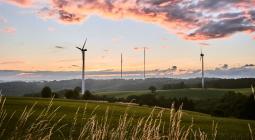Swedish firms ink deal to make green hydrogen with wind power

A project to produce green hydrogen using wind power is planned in the mid-east of Sweden, which is expected to have the ability to make up to 240 tons of the stuff on-site every day.
However, work on the proposed facility is not expected to begin until 2025, and it may not be operational until 2030.
The project is described as a partnership between wind farm operator WPD Offshore AB and Lhyfe, a green hydrogen producer. The pair said they intend to jointly install a 600MW hydrogen production plant in an industrial area of the municipality of Söderhamm, in the immediate vicinity of the Storgrundet offshore wind farm operated by WPD, to produce green hydrogen that can be used by industry as well as in the transport sector.
Lhyfe is using an electrolysis method to split water into hydrogen and oxygen. When produced using renewable energy, as it will be in this project, it is clean across the entire value chain from its production to its use, Lhyfe claims. In fact, hydrogen production can only be labeled "green hydrogen" if it is produced using renewable energy sources.
Luc Graré, head of International Business at Lhyfe, said the conditions in Sweden are ideal for this kind of project.
"The very good wind conditions and the country's ambitious climate goals offer very good conditions for the success of our joint project," he said in a statement. The cooperation with WPD and the connection to the Storgrundet wind project create great potential for the decarbonization of corresponding industries and the transport sector, he added. The firm's first industrial green hydrogen production facility went into live production last year.
The new plant is to be built from 2025 over the course of several project phases, and will be one of the largest hydrogen production sites in Europe once complete. It is expected to be in full operation in connection with the commissioning of the Storgrundet wind farm, currently expected to be commissioned in 2030.
Delivery of the hydrogen may be by pipeline to supply industrial sites, or distribution by truck to power vehicles, typically by hydrogen fuel cells.
However, Andrew Buss, research director for European Enterprise Infrastructure at IDC, previously warned that producing hydrogen can be very energy intensive and carry high production and distribution overheads, partly because hydrogen molecules are so small they can leak out of containers or pipes, making storage and transport a challenge on top of the energy required to produce it.
Buss was commenting on another green hydrogen project, the announcement by Dutch Data centre operator NorthC that it was switching its backup power generators at the company's facility in Groningen to a 500KW hydrogen fuel cell module to reduce consumption of diesel fuel.
The UK government unveiled its delayed hydrogen strategy last year, claiming that a UK-wide hydrogen economy could be worth £900m by 2030, and potentially £13b by 2050. ®




